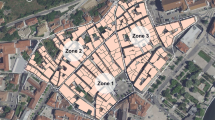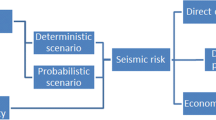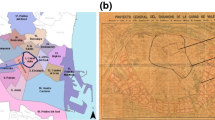Abstract
Seismic scenarios are tools used to assess seismic risk at the city level. This allows the assessment of the vulnerability of exposed elements to risk (buildings, bridges, etc.). In the case of Chlef city (formerly El Asnam), this evaluation type proves to be useful given the seismic hazard to which it is exposed and the building park size. This city has been shaken in the past by several earthquakes including that of the El Asnam 1980 (Ms = 7.3), which caused hundreds of casualties and destroyed 70% of the city. In this paper, a seismic vulnerability assessment at urban scale and three seismic damage scenarios are simulated using the “RISK-UE” methodology. First, a recreation of the El Asnam 1980 earthquake, considering the urban conditions of the 1980s, is done. A difference of about 12% between observed and simulated damage is observed. Secondly, two senarios considering the current urban conditions are simulated then, vulnerabilty curves are developed. The simulations purpose is to detect the most vulnerable typologies and districts in the event of a similar earthquake and to provide decision support elements to the local seismic risk manager. The results show a structural damage decrease compared to the 1980 urban conditions.
Similar content being viewed by others
References
Ambraseys, N. N., Douglas, J., Sarama, S. K., and Smit, P. M. (2005). “Equations for the estimation of strong ground motions from shallow crustal earthquakes using data from Europe and the Middle East: Horizontal peak ground acceleration and spectral acceleration.” Bull. Earthq. Eng., Vol. 3, No. 1, pp. 1–53, DOI: 10.1007/s10518-005-0183-0.
Amina, A., Foufa, A., and Benouar, D. (2010). “Investigation of the 1716 Algiers (Algeria) earthquake from historical sources: Effect, damages, and vulnerability.” International Journal of Architectural Heritage: Conservation, Analysis, and Restoration, Vol. 4, No. 3, pp. 270–293, DOI: 10.1080/15583050903161352.
Aoudia, A., Vaccari, F., Suhadolc, P., and Meghraoui, M. (2000). “Seismogenic potential and earthquake hazard assessment in the Tell Atlas of Algeria.” Journal of Seismology, Vol. 4, pp. 79–98, DOI: 10.1023/A:1009848714019.
Athmani, A. E., Gouasmia, A. E. H., Ferreira, T. M., Vicente, R., and Khemis, A. (2015). “Seismic vulnerability assessment of historical masonry buildings located in Annaba city (Algeria) using non adhoc data survey.” Bull. Earthquake Eng., Vol. 13, No. 8, pp. 2283–2307, DOI: 10.1007/s10518-014-9717-7.
Atkinson, G. and Sonley, E. (2000) “Empirical relationships between modified Mercalli intensity and response spectra.” Bull. Seis. Soc. Am., Vol. 90, pp. 537–544, DOI: 10.1785/0119990118.
Ayadi, A. and Bezzeghoud, M. (2015). “Seismicity of Algeria from 1365 to 2013: Maximum Observed Intensity Map (MOI by 2014).” Seismological Research Letters, Vol. 86, No. 1, pp. 1–9, DOI: 10.1785/0220140075.
Beldjoudi, H., Delouis, B., Heddar, A., Nouar, O. B., and Yelles-chaouche, A. (2012). “The Tadjena Earthquake (Mw = 5.0) of December 16, 2006 in the Cheliff Region (Northern Algeria): Waveform modelling, regional stresses, and relation with the Boukadir Fault.” Pure. Appl. Geophys, Vol. 169, No. 4, pp. 677–691, DOI: 10.1007/s00024-011-0337-8.
Benhamouche, A. (2014). “Seismic risk and damage prediction: case of the buildings in Constantine city (Algeria).” Bull. Earthquake Eng., Vol. 12, No. 6, pp. 2683–2704, DOI: 10.1007/s10518-014-9594-0.
Bertero, V. and Shah, H. (1983). El-Asnam, Algeria earthquake of October 10, 1980. A reconnaissance and engineering report, Report n° CETS CND-022, Earthquake Engineering Research Institute (EERI), California.
Bezzeghoud, M., Dimitrov, D., Ruegg, J. C., and Lammali, K. (1995). “Faulting mechanism of the 1954 and 1980earthquakes from vertical movements modelling.” Tectonophysics, Vol. 249, No. 3, pp. 249–266, DOI: 10.1016/0040-1951(95) 00032-I.
Boukri, M., Farsi, M., Mebarki, A., Belazougui, M., Amellal, O., Mezazigh, B., Bourenane, H., Benhamouche, A., and Guessoum, N. (2014). “Seismic risk and damage prediction: Case of the buildings in Constantine city (Algeria).” Bull. Earthquake Eng., Vol. 12, No. 6, pp. 2683–2704, DOI: 10.1007/s10518-014-9594-01001.
Dolce, M., Masi, A., Marino, M., and Vona, M. (2003). “Earthquake damage scenarios of Potenza town (Southern Italy) including site effects.” Bull. Earthquake Eng., Vol. 1, No. 1, pp. 115–140, DOI: 10.1023/A:1024809511362.
Farsi, M. and Lazzali, F. (2003). HOUSING REPORT Single-family reinforced concrete frame houses, Report No. 103, Earthquake Engineering Research Institute (EERI) and International Association for Earthquake Engineering (IAEE), Oakland.
Ferreira, T. M., Maio, R., and Vicente, R. (2017). “Analysis of the impact of large scale seismic retrofitting strategies through the application of a vulnerability-based approach on traditional masonry buildings.” Earthquake Engineering and Engineering Vibration, Vol. 16, No. 2, pp. 329–348, DOI: 10.1007/s11803-017-0385-x.
Giovinazzi, S. (2005). Vulnerability assessment and the damage scenario in seismic risk analysis, PhD Thesis, University of Florence, Italy.
Grünthal, G. (1998). European macroseismic scale 1998, Centre Européen de Géodynamique et de Séismologie, Luxemburg.
Guettiche, A., Guéguen, P., and Mimoune, M. (2017). “Seismic vulnerability assessment using association rule learning: Application to the city of Constantine, Algeria.” Natural Hazards, Vol. 86, No. 3, pp. 1223–1245, DOI: 10.1007/s11069-016-2739-5.
Hamdache, M., Peláez José, A., Talbi, A., and López Casado, C. (2010). “A unified catalog of main earthquakes for northern Algeria from A.D. 856 to 2008.” Seismological Research Letters, Vol. 81, No.5, pp. 732–739, DOI: 10.1785/gssrl.81.5.732.
Lagomarsino, S. and Giovinazzi, S. (2006). “Macroseismic and mechanical models for the vulnerability and damage assessment of current buildings.” Bull. Earthquake Eng., Vol. 4, No. 4, pp. 415–443, DOI: 10.1007/s10518-006-9024-z.
Lamego, P., Laurenço, P. B., Sousa, M. L., and Marques, R. (2016). “Seismic vulnerability and risk analysis of the old building stock at urban scale: Application to a neighbourhood in Lisbon.” Bull. Earthquake Eng., Vol. 15, No. 7, pp. 2901–2937, DOI: 10.1007/s10518-016-0072-8.
Lantada, N., Irizarry. J., Barbat. A.H., Goula, X., Roca, A., Susagna, T., and Pujades, L. G. (2010). “Seismic hazard and risk scenarios for Barcelona, Spain, using the Risk-UE vulnerability index method.” Bull. Earthquake Eng., Vol. 8, No. 2, pp. 201–229, DOI: 10.1007/s10518-009-9148-z.
Layadi, K., Semmane, F., and Yelles-Chaouche, A. K. (2016). “Siteeffects investigation in the City of Chlef (formerly El-Asnam), Algeria, using earthquake and ambient vibration data.” Bull. Seis. Soc. Am., Vol. 106, No. 5, pp. 1–12, DOI: 10.1785/0120150365.
Meghraoui, M. and Pondrelli, S. (2012). “Active tectonics around the Mediterranean. Active faulting and transpression tectonics along the plate boundary in North Africa.” Annals of Geophysics, Vol. 55, No. 5, pp. 955–967, DOI: 10.4401/ag-4970.
Meghraoui, M., Jaegy, R., Lammali, K., and Albarède, F. (1988). “Late Holocene earthquake sequences on the El Asnam (Algeria) thrust fault. ” Earth and Planetary Science Letters, Vol. 90, No. 2, pp. 187–203, DOI: 10.1016/0012-821X(88)90100-8.
Milutinovic, Z. V. and Trendafiloski, G. S. (2003). “An advanced approach to earthquake risk scenarios with applications to different European towns, WP4: Vulnerability of current buildings.” European Commission, p. 110.
Murphy, J. R. and O’Brien, L. J. (1977). “The correlation of peak ground acceleration amplitude with seismic intensity and other physical parameters.” Bull. Seis. Soc. Am., Vol. 67, No. 3, pp. 877–915.
NISEE, Earthquake Engineering Online Archive NISEE e-Library. https://doi.org/nisee.berkeley.edu/elibrary/about.html, Accessed 08 February 2015.
Novelli, V. I., D’Ayala, D., Makhloufi, N., Benouar, D., and Zekagh, A. (2015). “A procedure for the identification of the seismic vulnerability at territorial scale. Application to the Casbah of Algiers.” Bull. Earthquake Eng., Vol. 13, pp. 177–202, DOI: 10.1007/s10518-014-9666-1.
Petrovski, J., Petrovski, D., Auramov, A., Sesov, N., Salhi, N., Farsi, M., Milutinovic, A., and Dojcinovski, D. (1981). Studies for elaboration of the code for repair and strengthening of damaged buildings in the region of El Asnam-Vol. VII, Analysis of simple structures and damage distribution analysis, Report IZIIS82-55-7, Institute of Earthquake Engineering and Engineering Seismology, University of Kril and Metodij, Skopie.
RPA (2003). Règles Parasismiques Algériennes, Report DTR BC 2–48, Centre National de Recherche Appliquée en Génie Parasismique, Alger.
Sedan, O., Negulescu, C., Terrier, M., Roulle, A., Winter, T., and Bertil, D. (2013) “Armagedom-A tool for seismic risk assessment illustrated with applications.” J. Earthquake Eng., Vol. 17, No. 2, pp. 253–281, DOI: 10.1080/13632469.2012.726604.
Senouci, A., Bard, P. Y., Farsi, M. N., Beck, E., and Cartier, S. (2013). “Robustness and uncertainties of seismic damage estimates at urban scale: A methodological comparison on the example of the city of Oran (Algeria).” Bull. Earthquake Eng., Vol. 11, No. 4, pp. 1191–1215, DOI: 10.1007/s10518-012-9406-3.
Veludo, I., Teves-Costa, P., and Bard, P. (2013). “Damage seismic scenarios for Angra do Heroísmo, Azores (Portugal).” Bull. Earthquake Eng., Vol. 11, pp. 423–453, DOI: 10.1007/s10518-012-9399-y.
Wald, D., Quitoriano, V., Heaton, T., Kanamori, H., Scrivner, C., and Worden, C. (1999). “TriNetShakeMaps: Rapid generation of peak ground motion and intensity maps for earthquakes in southern California.” Earthquake Spectra, Vol. 15, pp. 537–555, DOI: 10.1193/1.1586057.
Woodward-Clyde Consultants (1984). Microzonation sismique de la région d’Ech Chliff Algérie, Technical Report, Ministere de l’habitat et de l’urbanisme, Alger.
Yelles-Chaouche, A., Boudiaf, A., Djellit, H., and Bracene, R. (2006). “La tectonique active de la région nord-Algérienne.” CR Geoscience, Vol. 338, pp. 126–139, DOI: 10.1016/j.crte.2005.11.002.
Author information
Authors and Affiliations
Corresponding author
Rights and permissions
About this article
Cite this article
Boutaraa, Z., Negulescu, C., Arab, A. et al. Buildings Vulnerability Assessment and Damage Seismic Scenarios at Urban Scale: Application to Chlef City (Algeria). KSCE J Civ Eng 22, 3948–3960 (2018). https://doi.org/10.1007/s12205-018-0961-2
Received:
Revised:
Accepted:
Published:
Issue Date:
DOI: https://doi.org/10.1007/s12205-018-0961-2




